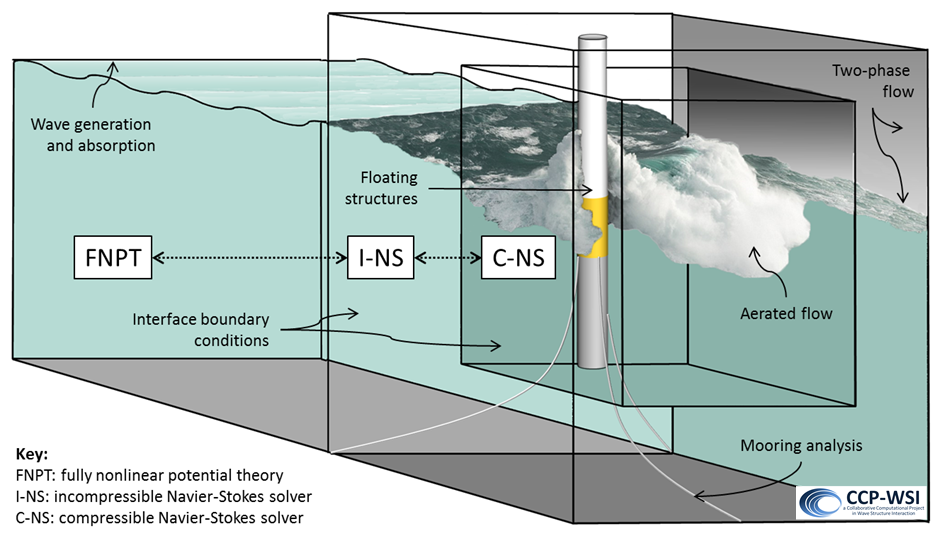
Complex wave structure interaction (WSI) challenges are significant in the offshore renewable energy sector and protection of coastal communities, strategic priorities for the UK. Established in 2015, the Computational Collaborative Project Wave Structure Interaction's (CCP-WSI) overarching aim was to build a community of researchers and developers, and to provide a focus for software development and code rationalisation with applications in these UK priority areas. In doing so, CCP-WSI provided strategic leadership for the WSI community, and generated impact in setting strategy, contributing knowledge, and developing software and its support.
Both the computational fluid dynamics (CFD) and structural mechanics (CSM) communities need computationally-efficient code development suitable for simulations of design cases of increasing complexity and scale. Many different codes are available commercially and are developed in academia, but it's uncertain how reliable they are in different applications, and the exact quality of the resulting simulations.
 "ZonalCFD is a concept in which the solution to
a wave-structure-interaction problem is decomposed spatially (into `zones') and
the most appropriate solver utilised in each, i.e. if the waves are not
breaking, a solver based on fully nonlinear
potential theory (FNPT) is likely to be adequate, but if breaking occurs a
Navier-Stokes (NS) solver is required, if air is trapped a compressible (C-NS)
solver is needed (and so on). This can be achieved within the same `model' or
by coupling different models at the boundaries of the zones. It is a strategy to optimise the simulation by only using the
computationally expensive solvers where necessary." Dr Edward Ransley
"ZonalCFD is a concept in which the solution to
a wave-structure-interaction problem is decomposed spatially (into `zones') and
the most appropriate solver utilised in each, i.e. if the waves are not
breaking, a solver based on fully nonlinear
potential theory (FNPT) is likely to be adequate, but if breaking occurs a
Navier-Stokes (NS) solver is required, if air is trapped a compressible (C-NS)
solver is needed (and so on). This can be achieved within the same `model' or
by coupling different models at the boundaries of the zones. It is a strategy to optimise the simulation by only using the
computationally expensive solvers where necessary." Dr Edward Ransley
Ransley, E., Greaves, D., Raby, A., Simmonds, D., Jakobsen, M., Kramer, M., RANS-VOF Modelling of the Wavestar Point Absorber, Renewable Energy, 109 (2017): 49-65
Combining the CFD and CSM communities is mutually beneficial, for example adding structural mechanics to the zonalCFD method (illustrated above) means CCPWSI+ will be able to simulate the interface between fluids and structures, thanks to the expert contributions from the two communities leading their respective fields. CCPWSI+ will continue to build on the work of the national Numerical Wave Tank (NWT) facility, and will accelerate the development of modelling across communities to address challenges in offshore and coastal engineering.
Led by Professor Deborah Greaves (University of Plymouth) CCP-WSI+ is funded for 5 years, from October 2020, and involves UK investigators and researchers, as well as academic and industry project partners across the world. Undoubtedly, this enhanced CCP will be propagating waves of both collaboration and progress throughout the course of its funding and well beyond!
